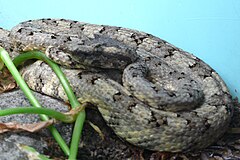Protobothrops
| Protobothrops[1] | |||
| Hoge & Romano-Hoge, 1983[2] | |||
 Przedstawiciel rodzaju – P. cornutus | |||
| Systematyka | |||
| Domena | |||
|---|---|---|---|
| Królestwo | |||
| Typ | |||
| Podtyp | |||
| Gromada | |||
| Podgromada | |||
| Rząd | |||
| Podrząd | |||
| Infrarząd | |||
| Nadrodzina |
Elapoidea | ||
| Rodzina | |||
| Podrodzina | |||
| Rodzaj |
Protobothrops | ||
| Typ nomenklatoryczny | |||
|
Bothrops flavoviridis Hallowell, 1861 | |||
| Synonimy | |||
|
| |||
| Gatunki | |||
| |||
Protobothrops – rodzaj jadowitych węży z podrodziny grzechotników (Crotalinae) w rodzinie żmijowatych (Viperidae).
Zasięg występowania[edytuj | edytuj kod]
Rodzaj obejmuje gatunki występujące w Azji (Chiny, Indie, Bhutan, Nepal, Bangladesz, Mjanma, Tajlandia, Laos, Wietnam, Japonia i Tajwan)[7][8].
Systematyka[edytuj | edytuj kod]
Etymologia[edytuj | edytuj kod]
- Protobothrops: gr. πρωτο- prōto- „pierwszy, świeży”[9]; rodzaj Bothrops Wagler, 1824[2].
- Triceratolepidophis: gr. τρεις treis, τριων triōn „trzy”; κερας keras, κερατος keratos „róg”; λεπις lepis, λεπιδος lepidos „łuska, płytka”, od λεπω lepō „łuszczyć”; οφις ophis, οφεως opheōs „wąż”[4]. Gatunek typowy: Triceratolepidophis sieversorum Ziegler, Herrmann, David, Orlov & Pauwels, 2000.
- Ceratrimeresurus: gr. κερας keras, κερατος keratos „róg”[10]; rodzaj Trimeresurus Lacépède, 1804[5]. Gatunek typowy: Ceratrimeresurus shenlii Liang & Liu, 2003 (= Trimeresurus cornutus M.A. Smith, 1930).
- Zhaoermia: Feng-Jiao Zhang, chiński herpetolog; rodzaj Ermia Zhang, 1992[6]. Nazwa zastępcza dla Ermia Zhang, 1992 (nazwa zajęta przez Ermia Popov, 1957 (Orthoptera)).
Podział systematyczny[edytuj | edytuj kod]
Do rodzaju należą następujące gatunki[7]:
- Protobothrops cornutus – trwożnica rogata[11]
- Protobothrops dabieshanensis
- Protobothrops elegans
- Protobothrops flavoviridis – trwożnica habu[12]
- Protobothrops himalayanus
- Protobothrops jerdonii
- Protobothrops kaulbacki
- Protobothrops mangshanensis
- Protobothrops maolanensis[13]
- Protobothrops mucrosquamatus – trwożnica chińska[11]
- Protobothrops sieversorum
- Protobothrops tokarensis
- Protobothrops trungkhanhensis
- Protobothrops xiangchengensis
Przypisy[edytuj | edytuj kod]
- ↑ Protobothrops, [w:] Integrated Taxonomic Information System (ang.).
- ↑ a b A.R. Hoge & S.A. Romano-Hoge. Notes on micro and ultrastructure of “Oberhäutschen” in Viperoide. „Memórias do Instituto Butantan”. 44/45, s. 96, 1982. (ang.).
- ↑ F.-J. Zhang: Division of the genus Trimeresurus (sensu lato) (Serpentes: Viperidae), based on the morphology of their skulls. W: E.-M. Zhao, B.-H. Chen & T. J. Papenfuss (red.): Proceedings of the First Asian Herpetology Meeting, Huangshan. Beijing: China Forestry Press, 1993, s. 48–57. (chiń.).
- ↑ a b T. Ziegler, H.-W, Herrmann, P. David, N.L. Orlov & O.S.G. Pauwels. Triceratolepidophis sieversorum, a New Genus and Species of Pitviper (Reptilia: Serpentes: Viperidae: Crotalinae) from Vietnam. „Russian Journal of Herpetology”. 7 (3), s. 201, 2000. (ang.).
- ↑ a b Q. Liang: Reptiles of Guangdong Nanling Nature Reserve. W: Z. Pang (red.): Studies on Biodiversity of the Guangdong Nanling National Nature Reserve. Guangzhou: Guangdong Science and Technology Press, 2003, s. 408–417. (chiń.).
- ↑ a b A. Gumprecht & F. Tillack. Proposal for a replacement name of the snake genus Ermia Zhang, 1993. „Russian Journal of Herpetology”. 11 (1), s. 73, 2004. (ang.).
- ↑ a b P. Uetz & J. Hallermann: Genus: Protobothrops. The Reptile Database. [dostęp 2019-11-20]. (ang.).
- ↑ R. Midtgaard: Protobothrops. RepFocus. [dostęp 2019-11-20]. (ang.).
- ↑ Jaeger 1944 ↓, s. 185.
- ↑ Jaeger 1944 ↓, s. 44.
- ↑ a b W. Jaroniewski: Jadowite węże świata. Warszawa: Wydawnictwa Szkolne i Pedagogiczne, 1984, s. 78–79. ISBN 83-02-00977-6.
- ↑ E. Keller (red.), J.H. Reinchholf, G. Steinbach, G. Diesener, U. Gruber, K. Janke, B. Kremer, B. Markl, J. Markl, A. Shlüter, A. Sigl & R. Witt: Gady i płazy. Warszawa: Świat Książki, 2003, s. 147, seria: Leksykon Zwierząt. ISBN 83-7311-873-X. (pol.).
- ↑ J.-H. Yang, N.L. Orlov & Y.-Y. Wang. A new species of pitviper of the genus Protobothrops from China (Squamata: Viperidae). „Zootaxa”. 2936, s. 59-68, 2011. (ang.).
Bibliografia[edytuj | edytuj kod]
- Edmund C. Jaeger, Source-book of biological names and terms, wyd. 1, Springfield: Charles C. Thomas, 1944, s. 1–256, OCLC 637083062 (ang.).
